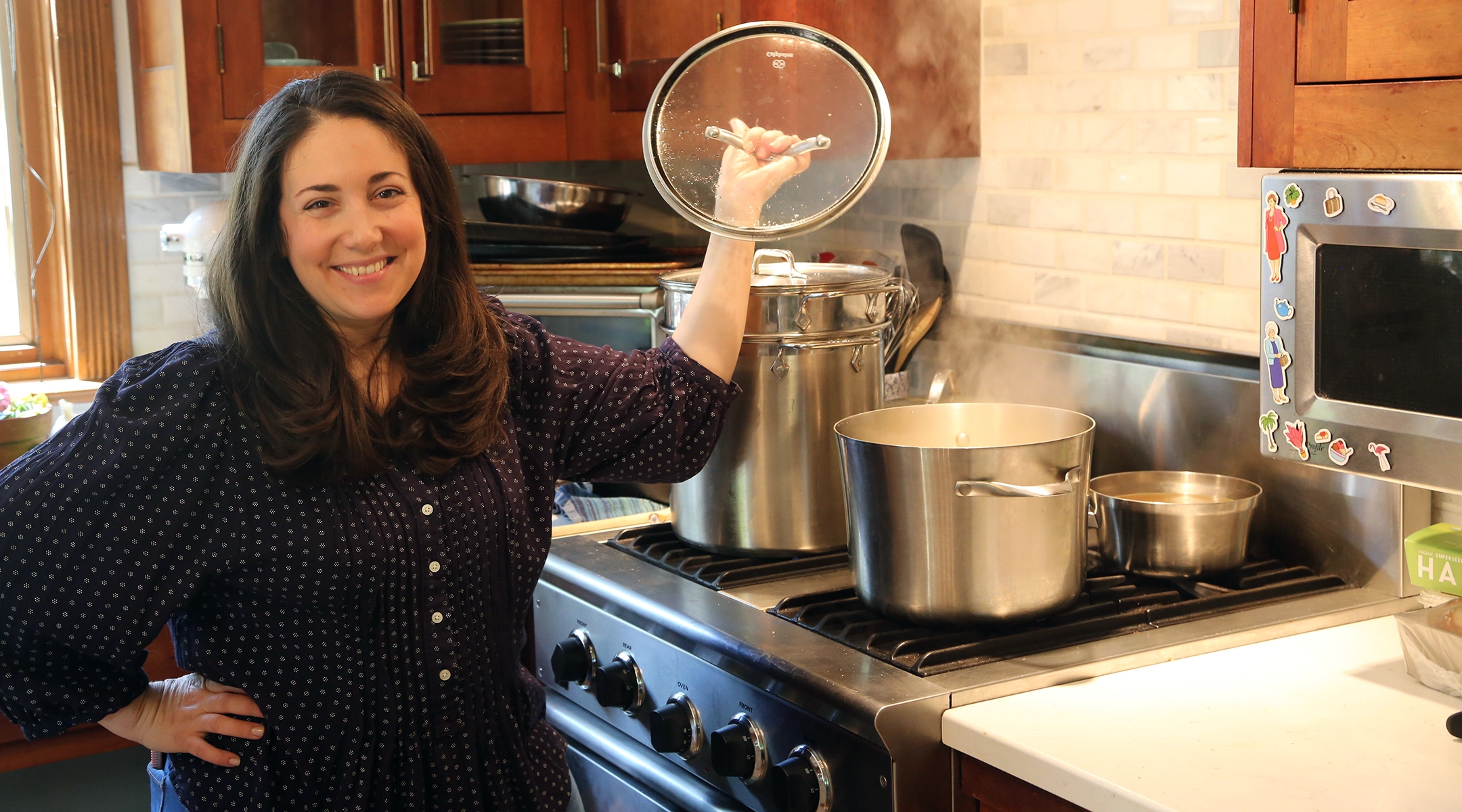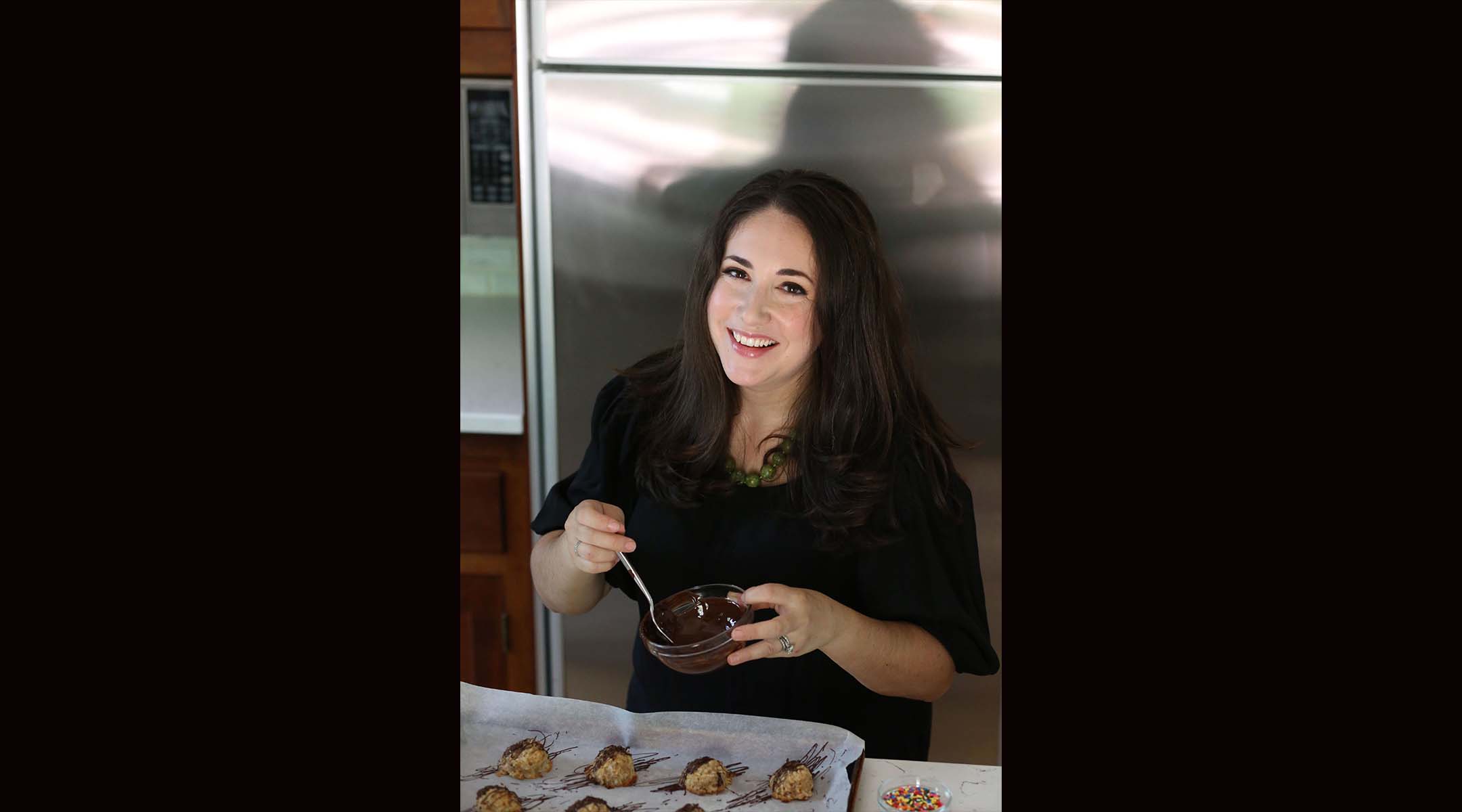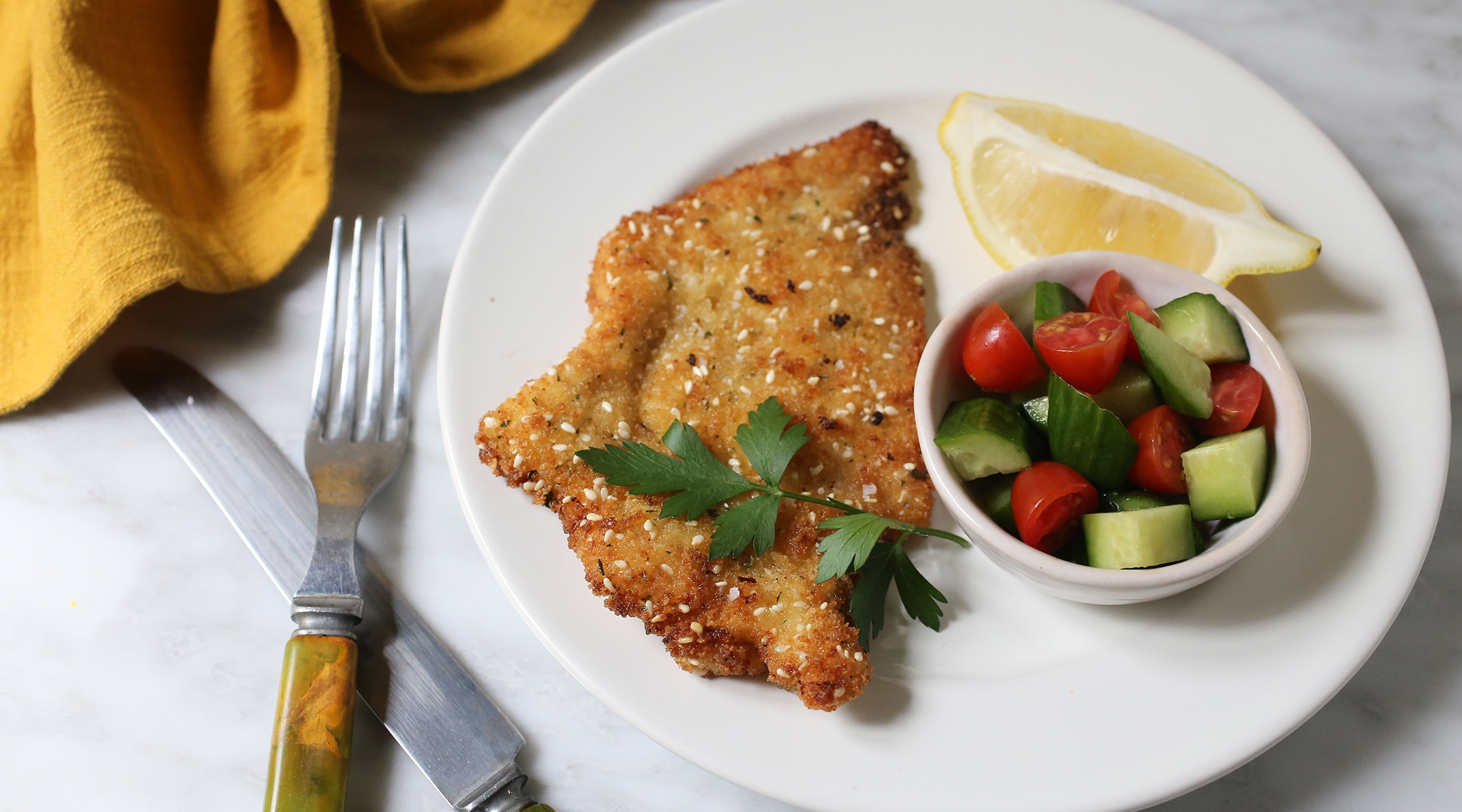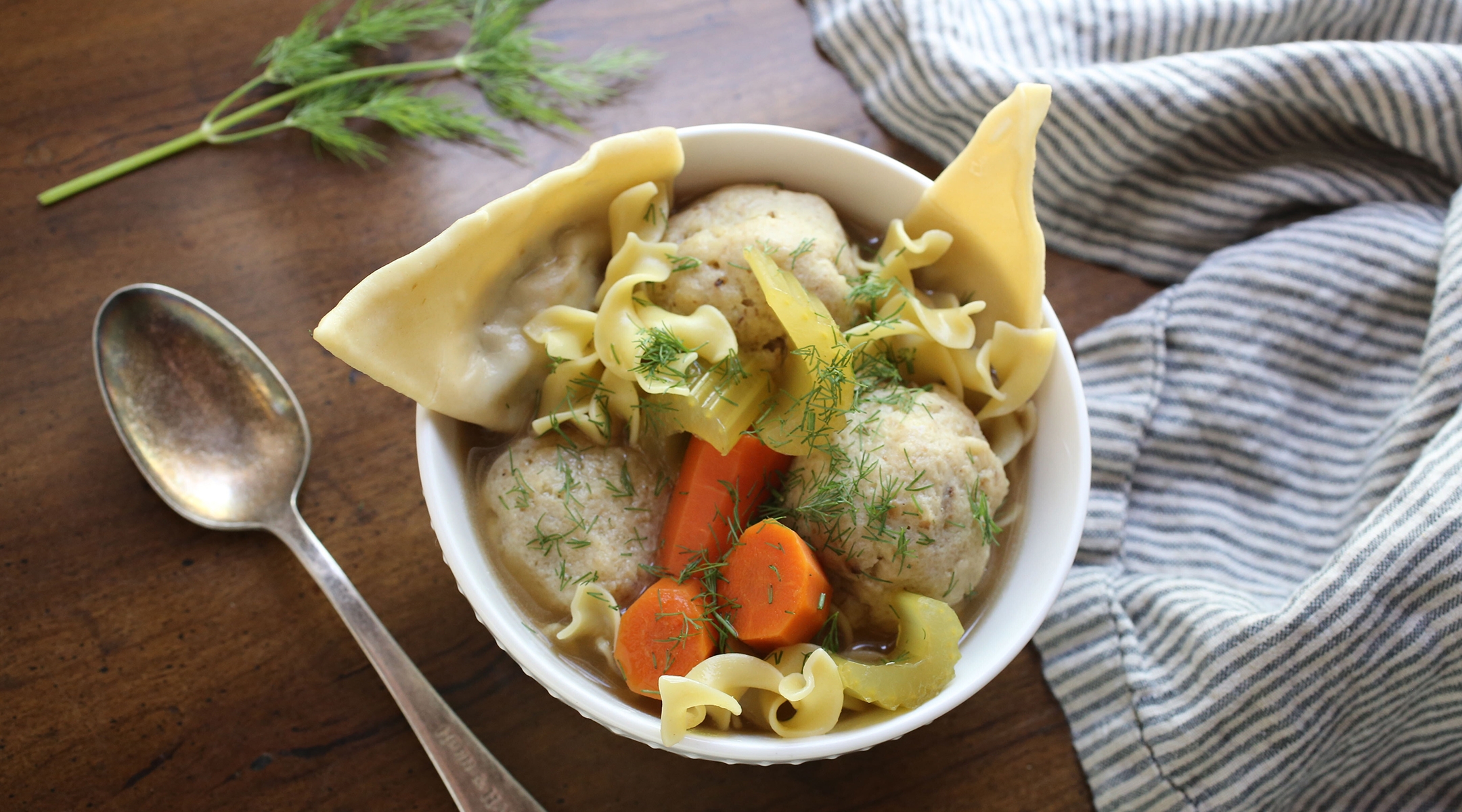Mac and cheese kugel, funfetti mandel bread, vegan shakshuka: ‘Modern Jewish Comfort Food’ gives classics a 21st-century spin
Shannon Sarna’s second cookbook guides readers through both familiar and surprising foods for every day

Shannon Sarna, author of “Modern Jewish Comfort Food,” stands over a pot of chicken soup, one of the many comfort food recipes in her new book. (Doug Schneider)
(JTA) – A steaming bowl of chicken soup. Crispy, flaky schnitzel. Rich, chocolate rugelach. These are the foods that come to mind for many when they hear the term “Jewish comfort food.”
What happens when one gives that tradition an uber-contemporary twist?
Some answers can be found in Shannon Sarna’s second cookbook, “Modern Jewish Comfort Food,” which was published last Tuesday: Thanksgiving turkey kreplach, funfetti mandel bread, mac and cheese kugel.
Sarna, who focused on giving baked goods the 21st-century treatment in her first book, “Modern Jewish Baker” (think banana bread chocolate chip challah and s’mores hamantaschen) is also editor of the Jewish food blog The Nosher (which is owned by 70 Faces Media, the Jewish Telegraphic Agency’s parent company). Her site regularly publishes content on international Jewish cuisine, so she naturally brings that Diasporic lens to her own recipes, too.
Take classic chicken soup — yes, she includes all the hits, along with her experiments — which is presented in a few versions, including a Yemenite style that incorporates ingredients such as ginger paste and marrow bones. Sarna’s shakshuka, the Israeli tomato and egg-based dish, can be modified into a Mexican-inspired version or a smoky vegan version.
The full package is mouth-watering and beginner friendly.
Sarna spoke to JTA about what comfort food means to her and what she hopes readers will take away from her book in trying times.
JTA: What is comfort food for you?
SS: I think it’s relatable. I think it’s unpretentious and that’s what I love. I can appreciate a fancy meal and I certainly can appreciate what those chefs do, but that’s the opposite of what I fall in love with and the opposite of what I want to produce. I think comfort food also speaks across cultures.
What should readers expect in the book?
This is very much a cookbook for home cooks, for people who want to learn, and for people who are going to really make the recipes. I wanted it to be something that people actually use in their kitchens.
I think one of the things I’ve learned in my role as editor of the Nosher is about how people learn visually, so having the step-by-steps in “Modern Jewish Baker” was an aspect that I wanted to recreate in this book.

Another hope for this book is that it will teach people a little bit about where the dishes came from and that it helps preserve these recipes and stories. Our family and our community life as Jews has changed so much in 100 years and 50 years, right? We’re not living in the same multi-generational communities as our parents and grandparents did, so it’s natural that some of the recipes and techniques behind dishes are lost. I want to share some of those how-tos in a visual way, and also share where these recipes fit into our history and into our next chapter as Jews.
After writing your last book, what inspired you to write about comfort food?
Comfort food is all about connection and, in these past few years that have been so hard for so many people, food can serve as a way of finding connection. So, I think comfort food very much speaks to this moment. I think it can be a point of connection beyond just Jews themselves, but helps us see the things that we have in common with other other people from all over the world and the ways in which the food tells our stories and that we can relate to one another.
You’re Jewish, Italian, and, of course, American — what has your background taught you about the similarity of comfort food across cultures?
I think that comfort foods speak to the story of people. We had a little bit and we had to make do with what we had – it’s a running theme that we all have in common. I feel like that’s the universality of comfort food to me.

What makes Jewish comfort food different from other cultures?
I think it’s our endless ability to adapt. We were exiled, moved somewhere else, started all over and managed to come up with something delicious that comes out of that. So I think that’s very much a story of American Jewish food. You know, so many of the foods here in the U.S. that we consider quintessential Jewish foods, really were born out of our immigrant experience.
What’s something you learned about comfort food in the process of writing the book?
As I was doing research for the book, I really came to understand that there were so many parallels between the immigrant experience of Jews coming here and Italians, Irish and Chinese immigrants all living together in the same neighborhoods in New York and influencing one another. That’s why you have rainbow cookies at every shul kiddush; that’s how you got lox on a bagel, and also spaghetti and meatballs. There were so many parallels of how these immigrant communities started out very poor, came here, used their resources and came up with these new dishes that were based on where they came from.

For someone who’s just now learning how to cook at home but craving something cozy, what’s the recipe you recommend?
I would tell them to make the sweet and sour meatballs or the schnitzel. They’re not complicated and if you learn how to fry some chicken and make some meatballs then you can make any kind of meatball and you can make any kind of fried thing. Just principles of doing those two tasks can translate to lots of different kinds of dishes. These are also dishes that I make for my family on rotation all the time.
What’s your favorite recipe in the book?
I fell in love with Georgian food very much through my job at the Nosher when years ago we went to create a video at this Georgian kosher restaurant in Queens called Marani. I was just enamored by the khachapuri and khinkali. I was eating something completely new to me but it felt like something I’d known all my life. So when I decided that I wanted to do different kinds of dumplings, I knew I wanted to do khinkali, which are Georgian meat dumplings. It was the most complicated recipe in the book for me to master. I spent a very long time watching YouTube tutorials in Russian at 11 o’clock at night on the couch with my husband over and over again. When I got it right, I was so happy and they’re so delicious.
This article originally appeared on JTA.org.























